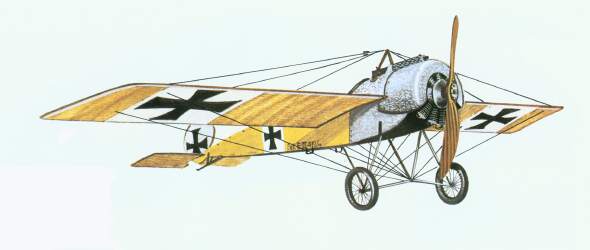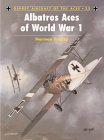Max Immelmann
First German Ace, 15 kills
By Stephen Sherman, Aug. 2001. Updated April 15, 2012.
In January 1916, Kaiser Wilhelm pinned Prussia's highest military honor, the Pour le Mérite, "The Blue Max," on two aviators, Oswald Boelcke and Max Immelmann. Immelmann's legend was confused and contradictory even then. A fierce fighter pilot, dubbed "The Eagle of Lille" by his opponents, he was a mamma's boy whose mother regularly sent him chocolates. The famous half-loop, half-roll maneuver that bears his name, the "Immelmann Turn," most likely was not his invention. Even his death remains clouded in conflicting and self-serving claims.
Youth
Born in Dresden in 1890, Max Immelmann entered the Dresden Cadet Corps at age fourteen.
While he was a gifted engineer, his behavior was unacceptable; he and the army parted ways eight years later. But when war broke out, the 24-year old was brought back into military service. He requested the aviation service, because of its mechanical and engineering aspects, but in the universal and timeless fashion of military bureaucracies, he was assigned to pilot training at Aldershof in November, 1914.
His record as a pilot trainee is unclear. Some source say he was a poor student. Others describe him as a natural. He learned on the Rumpler Taube, the Albatros, and the L.V.G.. His letters home described a fairly easy syllabus. He exceeded the requirements of his certification tests by wide margins: reaching 2,600 meters instead of 2,000; gliding 2,200 meters instead of 80; and staying aloft for 90 instead of 30 minutes.
He was an introvert; his closest friends seemed to be his mother and his dog, Tyras. No carousing and dancing with the young girls for him.
Initially he flew the mail and supplies to the German airdromes. He moved up to the Douai airfield. While flying a photographic plane on June 3, 1915, a French Farman shot him down. He landed the plane safely within his own lines, and surprisingly was decorated with the Iron Cross, Second Class for this.
Fokker Eindekker
Not long afterward, a young Dutch airplane designer, Anthony Fokker, arrived at Douai (Döberitz?) with two of his new monoplanes, each equipped with a potent innovation, a machine gun with interrupter gear that allowed it to fire forward through the propeller. Immelmann and Oswald Boelcke familiarized themselves with the Fokker E-I's, "Eindekker" and their revolutionary new weapons.
On August 1, ten British B.E.2c's bombed their Douai aerodrome. Boelcke and Immelman went after the departing Englishmen, but Boelcke's gun jammed after he had fired a few rounds. He landed to fix it and saw Immelmann attack the B.E.2's. Immelmann dived and fired, first at one plane, and then another. One started into a steep glide and Immelmann tailed it all the way to the ground. His gunfire had broken the pilot's elbow and forced him to land. On the ground, Immelmann approached the British pilot. They shook hands and Immelmann informed the Englishman that he was a prisoner. For this exploit, Max received the Iron Cross, First Class.
Immelmann scored again on September 9 and 21. But on the 23rd a French Farman shot up Max's plane, holing the fuel tank and destroying the landing gear. Somehow Immelmann survived and soon scored his fourth victory, a B.E.2c downed over Lille. His fifth a British biplane over Arras. On November 7, another B.E.2c for his sixth kill, and on December 5, his seventh claim, a Morane. By this time, the German press was idolizing him, Der Adler von Lille.
Der Adler von Lille
In the fall of 1915, Immelmann and Boelcke carried on a friendly rivalry, matching each other, victory for victory. Neither was a fancy flier. Immelmann wrote, "I do not employ tricks when I attack." In none of his writings does he refer to the half-loop, half-roll that bears his name. One source even suggested that Allied pilots used this maneuver to get away from Immelmann.
Aerial combat in the winter of 1915-16 was primitive and personal. On a mission over Lille, pilot Captain O'Hara Wood and gunner/observer Ira Jones, flying a BE-2c, had been warned of Immelman's presence in that sector. While gunner Jones had a Lewis gun, there were four different mounts for it; he had to lift the machine gun from one to the other when needed. A Fokker monoplane came after them, and quickly maneuvered into the BE-2c's blind spot: low and behind. Desperately, gunner Jones picked his Lewis gun up and fired it while holding it in his hands. The recoil of the heavy weapon and the violent movement of the airplane made him lose his grip, and it fell out of the plane. The two British fliers expected the worst, but the Fokker flew off, out of ammunition. Later Captain Wood informed Jones that their opponent had been the famous Max Immelmann, whom he had recognized by his skillful flying.
On January 12, 1916, Immelmann and Boelcke both scored their eighth victories, prompting their decoration with the Blue Max.
While Fokker's monoplanes had permitted Immelmann and Boelcke to excel, the other German aircraft builders had not been idle. Halberstadt and Albatros introduced competing planes. To keep up, Fokker mounted three Spandau machine guns on an Eindekker and installed a more powerful 100 HP engine. This was the E-III. In April, Max tested the E-III, but the interrupter gear couldn't handle three guns and the prop was blasted to bits. Fokker then tried two guns, but in late May, Immelmann "shot himself down" again.

By June of 1916, Immelmann's victories had mounted to 15.
Death
On June 18, Immelmann engaged some FE-2b's of RFC Squadron 25. According to British accounts, gunfire from an FE-2 piloted by Lt. G.R. McCubbin and gunned by Cpl. J. H. Waller hit Immelmann's Fokker and it dived into the ground. Perhaps the notion that a lowly two-seater FE-2 had brought down their leading ace, the Germans announced that he had been downed by anti-aircraft fire. This explanation also suited Tony Fokker, who filed a report noting that "the fuselage had been shot in two by shrapnel fire."
Other sources, including Max's brother Franz, blamed the interrupter gear, and claimed that amongst the wreckage, his propeller had been found, shot away right in line with his own guns. Most authorities concur with this explanation, but like so many events of World War One's aerial combat, the death of Max Immelmann remains obscured by conflicting reports and uncertainty.
Sources:
- The Aerodrome
- Heroes of the Sunlit Sky, by Arch Whitehouse, Doubleday, 1967
- The Canvas Falcons, by Stephen Longstreet, Barnes & Noble, 1970
- Knights of the Air, by Ezra Bowen, Time-Life Books, 1980
- Rand McNally Encyclopedia of Military Aircraft: 1914-1980, by Enzio Angelucci, The Military Press, 1983


